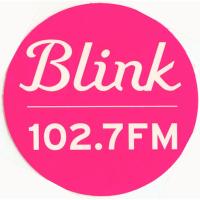
 I don’t remember exactly when, but at some point a decade or so ago, I wrote about WNEW New York’s short lived tenure as Blink 102.7, and a reader responded with something along the lines of “stop trying to make them some sort of brilliant, ahead-of-their-time radio station. They were a mess.”
I don’t remember exactly when, but at some point a decade or so ago, I wrote about WNEW New York’s short lived tenure as Blink 102.7, and a reader responded with something along the lines of “stop trying to make them some sort of brilliant, ahead-of-their-time radio station. They were a mess.”
The 20th anniversary of Infinity Broadcasting’s much-heralded station launch is next Monday, April 10. From this vantage point you can say that:
The “mess” part is true. Blink’s attempt at a broad Hot AC with E! Entertainment News values never jelled. Within a few months, PD Steve Kingston had evolved it to a (somewhat) more conventional Adult Top 40. By September, it changed again to more of a Mainstream AC. Then it went all-Christmas. That was five format variants in a year’s time, including a period of jockless CHR during the launch stunting.
The changes kept coming. After the holiday, Blink became Mix 102.7, although it evolved again to a Classic Dance format I loved under PD Rick Martini. In 2007, it became soft-but-contemporary Fresh 102.7, an exciting-enough concept in the industry that some stations paid to license the name, while rival WLTW was briefly concerned enough to drop the “Lite FM” name before modernizing itself. As Adult Top 40 “New 102.7,” WNEW has found its place over the last five years, currently leading the Hot AC battle with WKTU.
The “ahead of their time” part happened, too. Rhythmic Hot AC had already been the center for another “workout mix that didn’t work on the radio” station, KKBT (The Beat) Los Angeles, in the moments before it evolved to Hip-Hop/R&B. In 2003, when Hot AC was still working on the template designed for Modern AC five years earlier, pop/rock was still the dominant flavor of the format. It was not long after Blink’s demise that sister WWMX (Mix 106.5) Baltimore helped foster a more rhythmic-leaning version of the format. Now, rhythmic pop is a major presence on Adult CHR because of its dominance at Mainstream CHR.
The entertainment-news part took hold, too. Blink’s hourly entertainment reports were accused of not being updated-in-real-time enough. Today, the stock in trade of heavily voice-tracked radio is yesterday’s entertainment news, even though social media would now allow Blink (or any other station) to update almost constantly. The need to do so has been the pitch for Futuri’s TopicPulse product, as well as its recently announced “virtual DJ” RadioGPT extension.
The broad Hot AC music mix was already under development by rival teams of radio scientists. Blink landed about a year after the first “Bob-FM” and just as the first “Jack-FMs” were taking hold in Canada. Bob and Jack’s “hit Classic Rock plus Hot AC safelist” formula was easier to parse, particularly because unlike Blink, there weren’t also currents involved. Blink’s imaging, voiced by Kiefer Sutherland, was also offhand-sounding in a Jack-like way, although it worked better in a pop/rock context.
So does this actually make Blink influential? It is safe to say that nobody directly copied Blink, whose ambition and pre-launch publicity made it a target for schadenfreude from day 1. But every shuffling of the market landscape causes other moves, and that was the case for Blink as well. WKTU, which had been the market’s rhythmic-leaning Hot AC, would segue to a more gold-based format for the next five years, since one thing that Blink wasn’t doing was breaking new dance music. And WWMX, which certainly did have an influence on the format, was a sister station.
RadioInsight Publisher Lance Venta also notes some of Blink’s early technical innovations. The “Blinkline” was an early attempt at using AOL Instant Messenger to have direct online communication with listeners. Typing in “blinkline” on AIM allowed listeners to request songs. An automated response asked for artist name and song title, something pretty much unheard in those days. The launch of Blink also coincided with the station becoming the first to begin continuous operation in HD Radio.
Based on reporting at the time, there were already rumors that Infinity was eyeing Blink as a national brand. It seems like that model would have made a lot more sense, and would be a lot more likely in 2023. Then again, CBS Radio’s “Free FM” hot-talk format was a national launch and still had the same challenges of trying to do an ambitious new format with immediate public detractors and scrambling in public.
Here’s what I wrote about Blink at the time:
- The first five pages of Billboard’s April 18 Airplay Monitor, where I was editor at the time, are devoted to Blink, although we also made a point of including WHTZ (Z100)’s attempts to counterprogram by giving a greater showcase to recording artists at the time. There are two music monitors of Blink, one from the first hour and one several days later.
- There’s also an aircheck of the Blink launch from April 10, and another aircheck of Todd Newton on the station a month later. Things were happening fast enough at Blink that there aren’t any readily searchable airchecks between May and the station’s switch to Christmas, meaning nothing of mid-summer, when it sounded more Hot AC.
- The end of the entertainment news experiment came five months after the launch, just days after I made my transition from Billboard/Airplay Monitor to Edison Research. (As I recall, being able to share Blink intel helped get my calls answered in those first days.) Here’s the “First Listen” I wrote for the Edison website. It’s technically about the new, more mainstream AC station, but it also has ample post-mortem for the earlier Blink as well.
